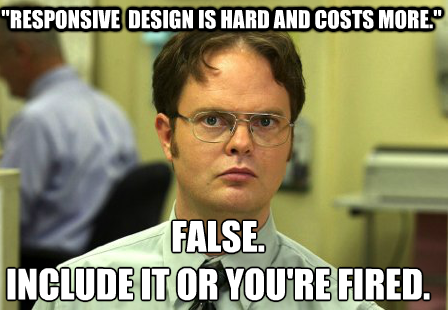
Understanding the True Value of a Website
Your website isn’t just a pretty online brochure. It’s an investment, a 24/7 salesperson, and the heartbeat of your online…
Read More
 Do not pay extra for responsive (responsible) web design, period.
Do not pay extra for responsive (responsible) web design, period.
But I would like you to read on to hear my thoughts. So please do so!
When you start on a new web project, you expect to get the best new features available, right? Well, I do. That is why we never charge extra for a responsive project.
First, what is responsive web design? According to Wikipedia, it is “a web design approach aimed at crafting sites to provide an optimal viewing experience – easy reading and navigation with a minimum of resizing, panning, and scrolling – across a wide range of devices (from mobile phones to desktop computer monitors).” In other words, it allows your website to automatically adjust based on the device that is accessing the site.
For a good example of a website designed responsively (and responsibly), check out a recent site that we built – Members 1st of NJ Federal Credit Union.
Responsive web design really only requires a little more CSS, and not much if you do it right! If you plan the project correctly and if you have a flexible development structure, the responsive design layouts basically build themselves.
I was at a web developer conference in Columbia, South Carolina, and companies were charging, 20-50% extra for responsive design. That is simply irresponsible and ass-backwards. Why are they charging extra? Simple, it is the “used car salesman approach.” Which is: Prey on the people who don’t know any better, and squeeze them for all you can. There is no other good reason to charge for the backbone of all “responsible” web projects. Don’t eliminate or ignore such a large and growing audience for your business. If you think that mobile technology and tablets are going away anytime soon, I have a bridge in NYC I am willing to sell you!
Responsive design is easy and extremely important to optimize your site’s layout based on the screen size of your user. It does not require that much extra code, and it makes a huge difference in the way consumers view your company. Old mobile sites, that were built way back in the EARLY 2000s used to sniff for the user’s device. Responsive design focuses on the breakpoints of the screen sizes for mobile phones, tablets, and computers. This allows for a centralized code base to control all of your “views.” That equals a significant amount of time and money that customers save in building and managing content on the site.
Now don’t get me wrong, situations exist where separate mobile sites are required, and for those sites, a separate build project is essential and should be priced separately. For the vast majority of websites on the Internet, however, a responsive design approach is perfect.
Bottom line: if you are building a new website, make sure that your developer is including a responsive design approach!
There are currently 4 responses.
September 3, 2014
False. Not all sites are intended to be accessible to an outside network. In the event you would want to make an intranet site available to all there is responsive design + security measures. This article is definitely not helpful for web developers.
September 3, 2014
Hi Jack,
As a developer myself, like you are, I appreciate your comments and feedback on the article.
The article was based on user interface and experience as it relates to the strategies we feel that other companies use to charge extra for services that are standard, not the security protocols or development technics. There are a ton of tutorials for that on the web.
Overall, if a site has very specific security requirements, like many government sites or sites that are using a CDN for flat publishing that is done outside of the UI/UX, right? Regardless of the security protocols, public or intranet viewing the usability & accessibility are always the number one priority of any website, intranet or web based solution. If not, why build it? It doesn’t matter how secure a site is, if no one can use it, it is useless.
As such, Ironistic.com is focused on how people use the site, how the site reacts to the users and what the ROI metrics are to evaluate the relationship with our clients. Common sense is also a metric that we use for development. Because of the increase in mobile usage across the world, we feel that there is no viable excuse not to provide current technology. Security is never going to go away and you have to work in tandem with it to provide robust solutions, not use it as an excuse not to build current solutions.
Why would you not want to build a site that is “mobile friendly” on internal networks? Isn’t it better for the user to be more accessible? Also, why would security be an issue with responsive design when the baseline technology and programming is unchanged? You don’t need a new code base, database or anything. You are just modifying the CSS and maybe some lines of code. Security is only an issue if the main website has security issues too, right?
Thanks,
Jared
October 9, 2013
Thanks for a great tip. Just curious what situations would require separate mobile sites? A friend is working with a developer and the verbiage “additional costs” if feasible for a real mobile version was discussed – Mmmmmm.
Thanks for your feedback.